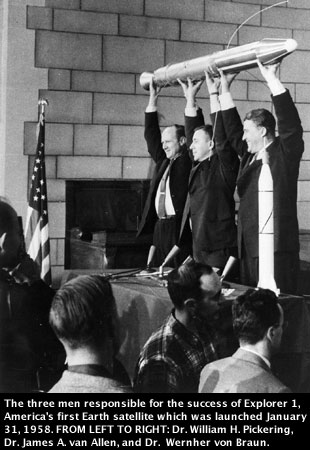|
|

|
Space "gem" marks sapphire anniversary
January 31, 2003 — At a mere 31 pounds, it was tiny by today's spacecraft standards. Yet, as it sprang skyward from Cape Canaveral 45 years ago today, the Explorer 1 satellite carried with it the enormous hopes and dreams of Cold War America. The country was still reeling from the Soviet Union's shocking launches of Sputnik 1 and 2, and the failure of its own first Vanguard launch, a month prior.

The Jupiter C rocket it rode upon was quickly swallowed by the night sky. For 90 long minutes President Dwight Eisenhower and America waited tensely to learn the fate of the mission. Finally, from a California desert tracking station came the message, "Goldstone has the bird." The United States had launched its first Earth-orbiting satellite and entered the space age.
Explorer 1 is remembered today for both its pioneering place in U.S. space history and immediate contributions to science, as the discoverer of the Van Allen Radiation Belts. For Explorer's developers at the Jet Propulsion Laboratory (JPL) in Pasadena, California, their memories are fond of the experience.
Dr. William Pickering, then JPL's director and leader of the project, recalled the media's reaction to Explorer 1's success. "We were told there was going to be a press conference at the National Academy of Sciences. About 2:00 a.m. [EST] we got into a car and drove over to the Academy. I can remember sitting in that car with [Dr. James] Van Allen and [Dr. Wernher] von Braun; just the three of us. I think all three of us wondered a little bit about what was going to happen and who was going to be there at that hour of the morning.
"They took us around to the back door of the Academy and into the great hall. It was completely filled with people. The media were there and very enthusiastic when we got there. At the end of [the press conference], I think all three of us realized that life was going to be different," Pickering said.
Explorer 1 began in 1954, when the Army authorized work on a joint Army-JPL program called Orbiter. In 1955, the U.S. Government announced plans to launch a scientific satellite during the International Geophysical Year. Orbiter competed with the Navy's Vanguard program, which won, partly because it relied less on military technology.
Despite the decision, JPL continued development of the Orbiter technology for use in tests of reentry heat shields for missiles. After Sputnik, Orbiter was renamed Explorer and approved for development as a backup program. With Vanguard's failure, Explorer 1 suddenly found itself front and center.
In just 84 days, Pickering and his team, working with the U.S. Army Ballistic Missile Agency in Alabama, military experts, U.S. academia, and rocket scientists such as von Braun, developed Explorer 1's science package and communications system, as well as the high-speed upper stages for the Jupiter-C rocket. The work changed JPL's emphasis from rockets to what would sit on top of them.
As Pickering described, "We regarded ourselves as the experts in the rocket business, having made both the Corporal and Sergeant rockets for the Army and having developed most of the underlying design features of the modern rocket, both liquid and solid. We were confident."
Explorer 1's primary science experiment was a cosmic ray detector built by Dr. James Van Allen of the State University of Iowa. It was designed to measure cosmic radiation, high-speed ions (atoms stripped of electrons) from the distant universe, in Earth's orbit. It sought to measure the flow of ions of the lowest energies, which are completely absorbed by the atmosphere and can't be studied from the ground.
Explorer 1 was launched into a highly elliptical orbit and carried no on-board tape recorder. Its data could only be collected when it was within range of a tracking station.
The data collection soon revealed a mystery: at the low points of the orbit the cosmic ray count was near the expected value, but at the high portions of the orbit none were counted at all. Van Allen theorized the instrument might have been saturated by very strong radiation from a belt of particles trapped by Earth's magnetic field.
Two months later, Explorer 3 confirmed the existence of these belts, which became known as the Van Allen Belts.
Explorer 1 made its final transmission on May 23, 1958. It entered the atmosphere and disintegrated on March 31, 1970, after circling the Earth more than 58,000 times. |
back to News

© 2023 collectSPACE.com All rights reserved.
Questions? E-mail contact@collectspace.com

|
|

|

|
